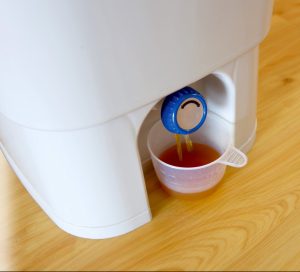Beneficial Bokashi
01 Jun 2022
Fermenting your kitchen scraps before composting them can prevent waste, sequester carbon and give your garden a boost.
By Sara Bruskin
We already appreciate fermentation for giving us sourdough bread, kimchi, beer and wine. It can also help us compost more effectively.
Bokashi composting has been practiced for centuries, but the first commercial system is generally attributed to Teruo Higa, a Japanese horticulture professor who developed it in 1982. Because the bokashi process ferments food scraps before they’re composted, you can include previously verboten items like meat, dairy and cooked food. The process also sequesters more carbon than a standard composting system and retains more nitrogen from the original organic matter, so the environment benefits along with your garden.
How It Works
The magic ingredient in this system is bokashi bran, a dry, organic material like wheat bran or rice bran that is inoculated with beneficial microorganisms that facilitate fermentation. With most composting systems, the microbes that break down food scraps require an aerobic environment (one with oxygen) to stay alive and active. That’s why compost piles decompose faster with periodic turning to introduce more air pockets into the mix.
A bokashi system, on the other hand, calls for an anaerobic environment (one without oxygen) so fermentation can take place. To create this, you can either invest in a bokashi bucket or make your own. A bokashi bucket needs a built-in reservoir at the bottom to catch liquid and a spout to drain it out so food scraps won’t sit in a puddle.
If you’re building your own bokashi bucket, use two nested 5-gallon buckets with a lid on top and holes drilled through the bottom of the inside bucket for drainage. Place a brick or other sturdy separator between the buckets to allow sufficient space for liquid to accumulate. If your bucket doesn’t have a spout, you’ll have to lift out the inside bucket periodically to access the liquid and pour it out.
Fill It Up
To begin the composting process, sprinkle a small handful of bokashi bran at the bottom of the bucket. Layer about 2 inches of accumulated food scraps at a time and sprinkle more bran on top. Don’t use moldy or rotten scraps; their fungi and bacteria may outcompete the beneficial microbes in the bokashi bran. Use a weight to squish down the organic material and remove air pockets, and always keep the bucket covered when you’re not adding to it.
White mold may develop inside the bucket. This is fine, but if you see black, blue or green mold, you’re probably not using enough bokashi bran. Try adding more to fix the problem or discard that batch and start again.
When the bucket is full, add more bran on top and allow it to sit with the lid on for two to three more weeks. (Many people use two bokashi systems so they can add to one while the other is full and fermenting.) Afterwards, the food scraps will retain their original shape, but they’ll be fully fermented.
The scraps can then be buried directly in a garden bed, about 8 to 12 inches below the surface. They’ll be highly acidic at first, so don’t bury them too close to your current plants and wait two to three weeks before growing anything in that spot. Alternatively, you can add the fermented scraps to a compost pile where they’ll break down much faster than non-fermented scraps. They also won’t smell as much as traditional compost or attract pests.
 Teatime
Teatime
The liquid that drains out of a bokashi bucket is known as bokashi “tea,” and it’s high in beneficial microbes as well as potassium and phosphorus. It can be used as a fertilizer when diluted to a strength of 1:100. At full strength, it’s great for household plumbing because the microorganisms break down fat deposits, so pour it down sink drains to keep pipes clear of buildup.












